Prettejohn E. Beauty and Art: 1750-2000 (Oxford History of Art)
Подождите немного. Документ загружается.



In 1854 the art critic and theorist John Ruskin (1819–1900) wrote to the
editor of The Times in defence of a painting, on view at the Royal
Academy in London, which he thought had been misunderstood: The
Awakening Conscience [64] by William Holman Hunt (1827–1910), one
of the seven members of the Pre-Raphaelite Brotherhood. Ruskin
acknowledged the overwhelming visual complexity of the picture, but
showed his readers how a close observation of its multitudinous details
could yield meaning. He reformulated the visual evidence into a
sequential narrative: ‘The poor girl has been sitting singing with her
seducer; some chance words of the song, “Oft in the stilly night,” have
struck upon the numbed places of her heart; she has started up in
agony; he, not seeing her face, goes on singing, striking the keys care-
lessly with his gloved hand.’ For Ruskin this story, together with its
moral implications, is unequivocally more important than the beauty
of the work; indeed, he finds the woman’s face more moving because it
is ‘rent from its beauty into sudden horror’. The interior setting is
‘common, modern, vulgar’, but its very ugliness reinforces the message
of the narrative. It shows that this is not a family home, but a place
decorated too gaudily, where a man keeps his mistress: ‘That furniture
so carefully painted, even to the last vein of the rosewood—is there
nothing to be learnt from that terrible lustre of it, from its fatal
newness; nothing there that has the old thoughts of home upon it, or
that is ever to become a part of home?’ Every object in the room is
tainted by belonging to this illicit ménage, and its physical ugliness is
an index of its moral badness: the expensive embossed books on the
table are brand-new, unread, therefore ‘vain and useless’, and the
neglected cat is dismembering a bird on the carpet. Ruskin even denies
us visual pleasure in a lovely detail: ‘nay, the very hem of the poor girl’s
dress, at which the painter has laboured so closely, thread by thread,
has story in it, if we think how soon its pure whiteness may be soiled
with dust and rain, her outcast feet failing in the street’. This extends
the narrative into the future, predicting the woman’s ruin, which for
Ruskin is an inevitable consequence of her sinfulness. Moreover, the
same logic of inexorable cause and effect applies to the painting itself:
the scrupulous honesty with which the painter has represented his
111
3
Detail of 64
Victorian England:
Ruskin, Swinburne,
Pater
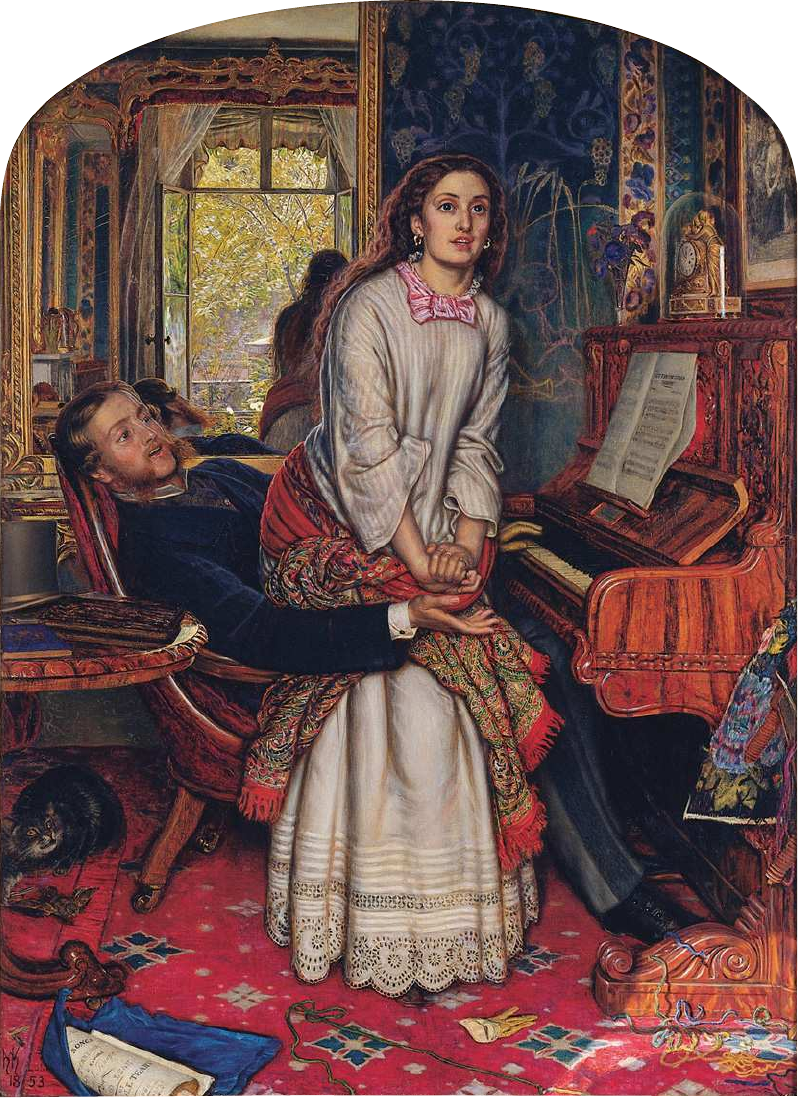
112 victorian england: ruskin, swinburne, pater

victorian england: ruskin, swinburne, pater 113
64 William Holman Hunt
The Awakening Conscience,
1853–4 (retouched later)
subject, down to the very threads of the hem, will guarantee its effec-
tiveness in delivering its message. ‘Examine the whole range of the
walls of the Academy’, Ruskin concludes: ‘there will not be found one
[picture] powerful as this to meet full in the front the moral evil of the
age in which it is painted’.
1
Ruskin presents The Awakening Conscience as just the kind of paint-
ing that French proponents of a social art were demanding at the same
moment: a modern-life subject, relentlessly honest in its portrayal of
ungainly furniture and ugly costumes, and aimed at social reform in
the real world. Moreover, this is not, for Ruskin, simply to do with
subject-matter. Ruskin shows clearly how the minutiae of the picture’s
execution are integral not only to the ‘realism’ of its representation of
the external world, but equally to its effectiveness in delivering its
messages. A detail such as the hem not only records observed fact with
scrupulous exactitude, but also elaborates the pictorial narrative and
its social implications; at the same time it serves as a sign of the paint-
er’s integrity. Thus the critical account fulfils one of Ruskin’s most
cherished aims: to prove that visual art is no mere entertainment or
pastime, but instead is thoroughly integrated with the most urgent
social, moral, and political issues of the modern world. For Ruskin it is
vital that everything about the picture should be interconnected, that
the tiniest visual detail (such as the hem) should signify the greatest
moral truth (the inevitability of retribution for sin). In the process, he
taught his readers in Victorian England—and can still teach us—to see
much more in pictures than we should have thought possible, to look
as industriously as Hunt painted.
Yet Ruskin’s analysis leaves little room for the free play of the spec-
tator’s imagination; it is locked into a moral system that exists prior to,
and independently of, the picture itself, one in which sexual immorality
entails doom as certainly as the sincerity of the painter’s labour guaran-
tees the picture’s worth. For all the closeness of his observation, Ruskin
is unable to see clues to different stories: the brilliant sunlight of the
garden towards which the woman raises her eyes, and which we see
reflected in the background mirror, could be taken to prophesy the
woman’s moral redemption or her emancipation from her seducer.
Hunt had elaborated the visual signs in his picture as comprehensively
as his medium would permit, and yet they still could not deliver a
meaning that was as fully determined as Ruskin desired. If they did,
there would have been no need for Ruskin to write to The Times in the
first place. But if, on the other hand, all Hunt’s diligence was still not
enough to guarantee perfect intelligibility, was Ruskin perhaps mis-
taken in believing that art could, or should, be fully integrated with the
world around it?
In the next decade a group of English painters, many of whom came
from the Pre-Raphaelite circle itself, comprehensively unpicked the
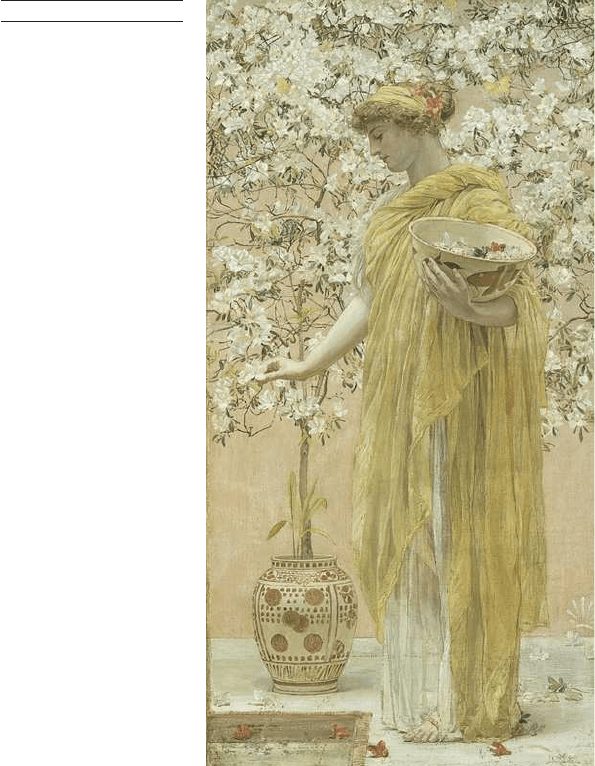
114 victorian england: ruskin, swinburne, pater
knot that, in Ruskin’s criticism, bound art to the external world, through
narrative, visual realism, and moral didacticism. Azaleas, exhibited in
1868 by Albert Moore (1841–93, 65), contains no clues to a story in
which cause-and-effect morality might operate. Indeed, it is practically
devoid of human interest: the face of the figure expresses no emotion,
and the title gives no hint of her moral character or social rank. Instead,
it names a still-life object, the azalea, which is visually gorgeous but
apparently meaningless. The various accessories do not define a coher-
ent historical setting: the woman’s draperies are classicizing, but the
carp bowl, the decorations of the azalea pot, and the asymmetrical
arrangement of blossoms are Japanese in sensibility. The colour scheme
is artificially limited to a narrow range of hues—white, yellow, and
beige, with a few carefully placed accents of deeper red-orange. More-
over, the mesmerizing rhythms of the compositional lines appear to
obey a mathematical logic rather than naturalistic spontaneity. The
65 Albert Moore
Azaleas, 1868
victorian england: ruskin, swinburne, pater 115
poet Algernon Charles Swinburne (1837–1909), commenting on the
picture in his review of the exhibition, made no attempt to provide it
with a narrative or derive a moral from it. Instead he emphasized its
purely artistic character by likening it to poetry and music:
His painting is to artists what the verse of Théophile Gautier is to poets; the
faultless and secure expression of an exclusive worship of things formally
beautiful. . . . The melody of colour, the symphony of form is complete: one
more beautiful thing is achieved, one more delight is born into the world; and
its meaning is beauty; and its reason for being is to be.
2
Ruskin, Venetian painting, and Rossetti
In his magisterial work of art theory, Modern Painters (published in five
volumes, 1843–60), Ruskin showed himself acutely sensitive to the
beauty both of the natural world and of art. But he was also unequivo-
cally hostile to German aesthetics. At the beginning of volume II,
which deals with ‘Ideas of Beauty’, he repudiates the very word ‘aes-
thetic’, because of its etymological link with sensuous experience, and
proposes a different term, ‘theoretic’, to refer to the human faculty for
receiving ideas of beauty: ‘Now the mere animal consciousness of
the pleasantness [of visible objects] I call Æsthesis; but the exulting,
reverent, and grateful perception of it I call Theoria’.
3
This sounds
something like Kant’s distinction between the agreeable, as pleasing
merely to the senses, and the beautiful; but Ruskin cannot follow
Kant’s next step, which is to distinguish the beautiful also from the
good. For Ruskin the perception of the beautiful is inherently moral,
because it responds joyfully to God’s creation and because it is itself
a faculty given to humans by a loving God. His condemnation of
Schiller’s Aesthetic Letters, several chapters later, involves the same
issue; it is ‘gross and inconceivable falsity’ to maintain, as Ruskin
claims Schiller does, that ‘the sense of beauty never farthered the per-
formance of a single duty’.
4
This is a superficial reading of Schiller’s
notion of aesthetic determinability (see above, pp. 45‒61), for Ruskin
ignores the wider role Schiller gives to beauty in freeing the mind from
enslavement to prejudice and tradition, and thus opening the way
for innovation. But Ruskin craves a world where human capacities are
wholly integrated with one another and with external, God-given
‘reality’, not one in which human beings may enact radical change.
The theory of beauty presented in the first two volumes of Modern
Painters, published in 1843 and 1846, can be described as an ambitious
attempt at reconciling a strong Protestant faith with a genuine love of
both natural and artistic beauty. Ruskin redeemed visual art from tradi-
tional Protestant misgivings about its sensuality by applying a rigorous
version of the work ethic to its study. Yet the very integrity of Ruskin’s
methods of visual observation eventually threatened the enabling
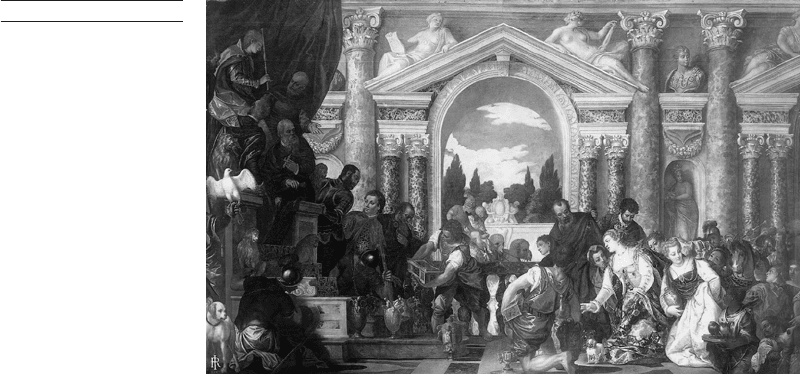
116 victorian england: ruskin, swinburne, pater
premise of his project, that ideas of beauty could be kept distinct from
the merely sensuous. For Ruskin it was the study of Venetian Renais-
sance painting, traditionally valued for its sensuous appeal, that forced
a revaluation of his theory. In 1858, contemplating Solomon and the
Queen of Sheba by Paolo Veronese (c.1528–88, 66), Ruskin suddenly
experienced a powerful sense of the sheer physical beauty of the paint-
ing. So intimately bound up with his religious faith were his ideas on
art and beauty that a change in the one could not but affect the other,
and Ruskin’s new conviction of the importance of sensuous experience
led him, at least temporarily, to renounce the evangelical Protestantism
of his upbringing. As he later put it, he came away ‘a conclusively un-
converted man’.
5
In the final volume of Modern Painters, published in
1860, he adopts a startlingly new position. Taking Titian as the ‘central
type’ of the Venetian attitude, he writes: ‘the painter saw that sensual
passion in man was, not only a fact, but a Divine fact; the human crea-
ture, though the highest of the animals, was, nevertheless, a perfect
animal, and his happiness, health, and nobleness, depended on the due
power of every animal passion, as well as the cultivation of every spiri-
tual tendency’.
6
Although this insight continued to cause Ruskin the
gravest misgivings, it made a powerful impact on readers who looked
to him as the foremost English authority on the visual arts.
The year after Ruskin’s ‘un-conversion’, the Pre-Raphaelite painter
Dante Gabriel Rossetti (1828–82) embarked on a practical experiment
in re-creating the style of Venetian Renaissance painting. Perhaps
Rossetti, at the time a close friend of Ruskin’s, was responding to the
critic’s new interest in Venetian painting when he began a simple panel
picture of a single female head and shoulders [67]. The composition
is reminiscent of Venetian portraits, and in a contemporary letter
Rossetti described the work as a technical exercise in learning to paint
human flesh, something for which Venetian painters such as Titian
66 Paolo Veronese
Solomon and the Queen of
Sheba
, c.1582
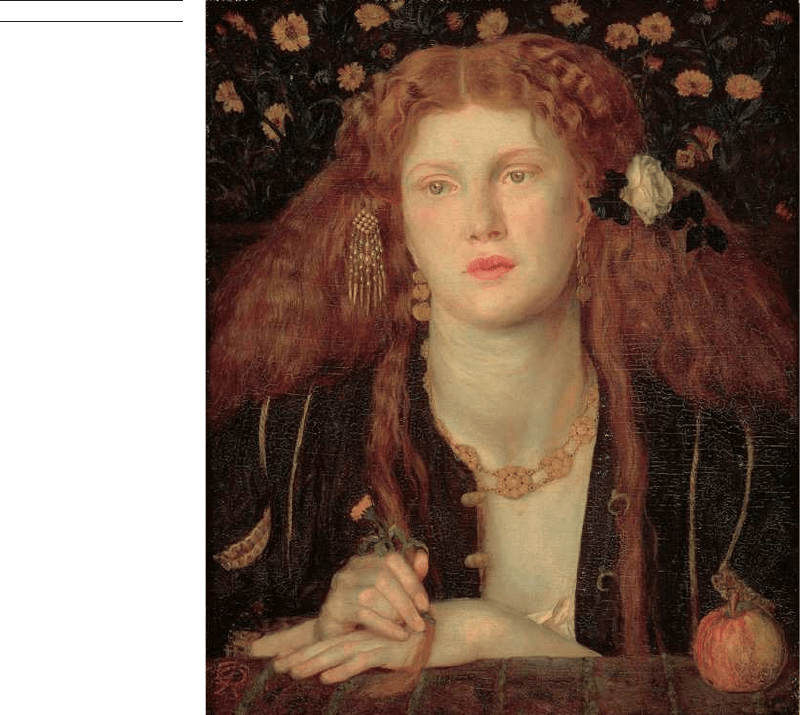
victorian england: ruskin, swinburne, pater 117
67 Dante Gabriel Rossetti
Bocca Baciata, 1859
were justly famous. He continued: ‘Even among the old good painters,
their portraits & simpler pictures are almost always their masterpieces
for colour & execution’. In another letter he describes his picture as
having ‘a rather Venetian aspect’.
7
Rossetti used this experimental picture to develop a wholly new
technical method, quite unlike the Pre-Raphaelite method seen in pic-
tures such as Hunt’s The Awakening Conscience. Instead of painting
thinly in bright, unmixed colours, Rossetti now built up a complex
sequence of layers of rich colour; the meticulous individual brush-
strokes of Pre-Raphaelite practice are replaced with carefully blended
areas of broad modelling. Thus the paint surface itself, apart from what
is represented in the picture, has a lusciousness and tactility quite alien
to the more ascetic practice of Pre-Raphaelite painting. But Rossetti
also uses this new style to enhance the sensuality of the represented
figure, full-lipped and fleshy, adorned with jewels and flowers, and
dreamy-eyed. The figure is based on a contemporary model, Fanny
Cornforth (1835–c.1906). But it is equally based on portraits by Titian
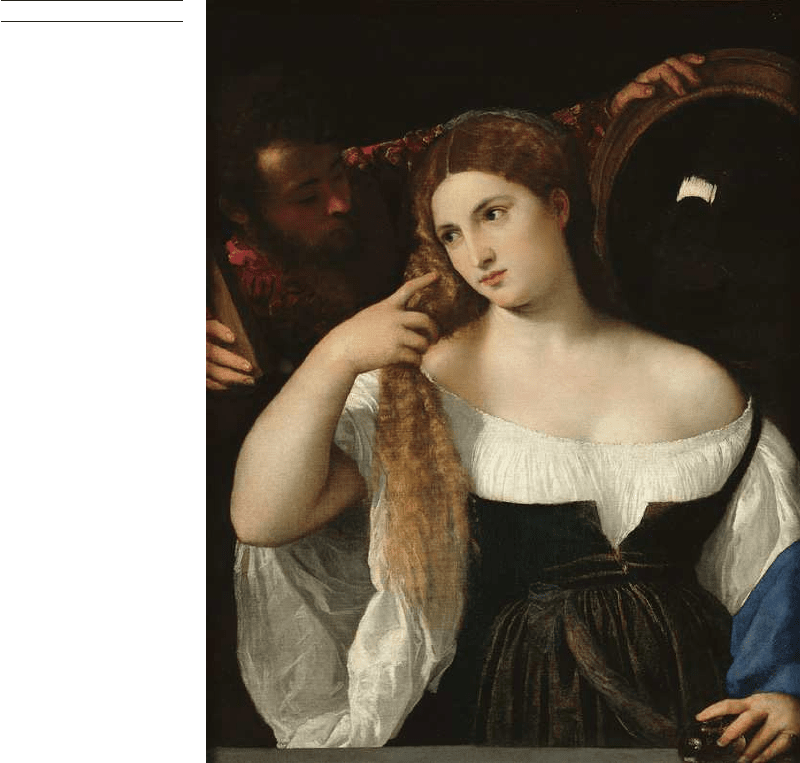
118 victorian england: ruskin, swinburne, pater
and other Venetian painters of sensual women (for example 68); the
close-up presentation of the figure, the luxurious accessories, and the
abundant red hair are all reminiscent of Venetian painting.
It seems to have been only after the picture was painted that Rossetti
gave it a title, and with it a hint of subject-matter: Bocca Baciata, ‘the
mouth that has been kissed’. The reference is to the final line of a tale in
the Decameron, by Giovanni Boccaccio (1313–75), in which the principal
character, Alatiel, is the most beautiful woman in the world, and
the most sensual; she exchanges sexual delights with eight men before
marrying a ninth. In an abrupt reversal of the narrative of inevitable
ruin for the fallen woman, Alatiel lives happily ever after, and the final
line can be read as a celebration of promiscuity: ‘the mouth that has
been kissed does not lose its fortune, rather it renews itself just as the
moon does’. Thus the title is perfectly adapted to the heady sensuality
of the picture itself, but, importantly, it was an afterthought: the mean-
68 Titian
Woman with a Mirror,
1514–15
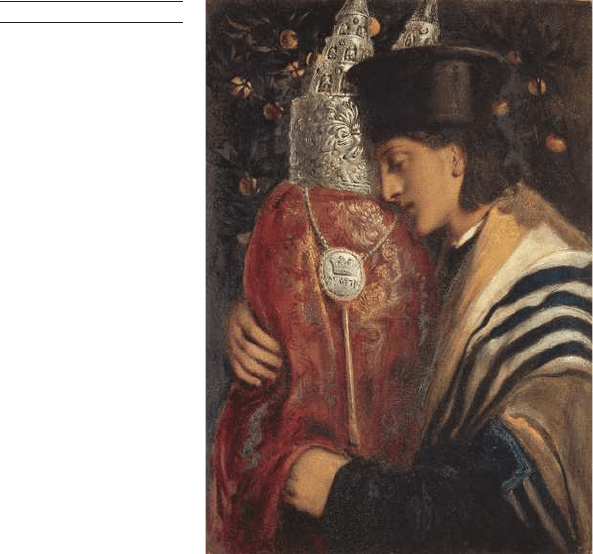
victorian england: ruskin, swinburne, pater 119
69 Simeon Solomon
Carrying the Scrolls of the
Law
, 1867
ings of the picture were created in visual terms, and the literary content
was chosen later to amplify the picture’s ‘aesthetic ideas’.
If Ruskin’s new-found enthusiasm for Venetian painting was one
motivation for Rossetti, the work ended in flagrant defiance of Ruskin’s
own earlier advocacy of the ‘theoretic’ over the ‘aesthetic’: it is a power-
ful visual argument in favour of the pleasures of the senses as an
appropriate subject for painting, apart from any moral or didactic con-
siderations. More than that, it presents sensuous and erotic pleasures as
inseparable. Holman Hunt was horrified: ‘I will not scruple to say that
it impresses me as very remarkable in power of execution—but still
more remarkable for gross sensuality of a revolting kind.... Rossetti is
advocating as a principle the mere gratification of the eye and if any
passion at all—the animal passion to be the aim of art.’
8
Nonetheless,
Rossetti’s experiment in the purely ‘aesthetic’ caught on; within the
next few years a number of painters in the social circles linked to Ros-
setti made pictures of single figures that had no evident purpose but to
delight the senses. Rossetti’s brother, the art critic William Michael
Rossetti (1829–1919), described works exhibited in 1863 by Frederic
Leighton (1830–96), including A Girl with a Basket of Fruit [70], as ‘the
art of luxurious exquisiteness; beauty, for beauty’s sake; colour, light,
form, choice details, for their own sake, or for beauty’s’.
9
Rossetti’s
friend Simeon Solomon (1840–1905) produced a variant that features
the male figure [69]. The photographers David Wilkie Wynfield
